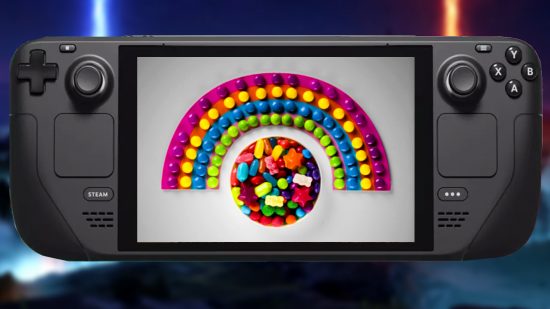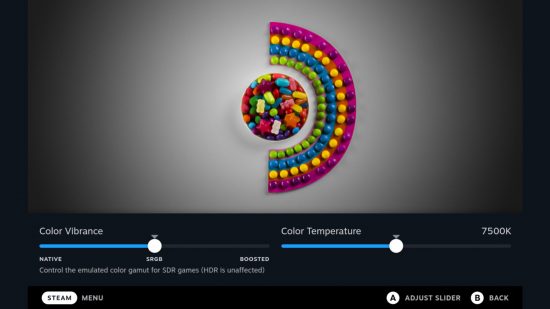A new Steam Deck update is here from Valve, and the arrival of SteamOS 3.5 on the preview channel gives you the chance to check out what the latest operating system looks like for the plucky handheld. The big news here is in visual improvements – new Steam Deck color display settings akin to those of a desktop gaming PC allow you to opt for more vibrant or warm options, which can be tweaked to your liking while playing a game, while HDR and VRR support for external displays will make the visuals pop even more. There’s also a welcome fix for an CPU issue that required SMT to be manually disabled by users to resolve.
The new ‘Adjust Display Colors’ menu can be found in your Steam Deck settings, and lets you adjust both Color Vibrancy and Color Temperature settings. The former gives you a choice between ‘Native’ (the appearance used prior to this update), ‘sRGB’ (the new default setting, using Microsoft’s sRGB color gamut for a slightly warmer and more vibrant look), and ‘Boosted’ (a wider-gamut appearance, which increases vibrance but Valve warns “may result in gradient clipping”).
The second setting lets you tweak the temperature of the Steam Deck display, enhancing reds for a warmer feel or blues for a cooler look. This is likely to come down to personal preference, although it may well be a welcome solution to those of us who suffer from eye strain while looking at screens for extended periods. You can adjust these settings on the fly using a test image, or using your currently running game.
In addition to this, HDR (high dynamic range) and VRR (variable refresh rate) can now be enabled while using an external display, providing they are supported by the display in question. Both of these can help your games look even better – HDR by enhancing the effect of bright lights and dark zones, and VRR by automatically and seamlessly adjusting to your display’s refresh rate for a smoother experience. Note that VRR requires a compatible USB-C adapter, so ensure you’re using the best Steam Deck dock for an optimal experience.
Among the other changes is a fix to touchscreen orientation while using an external display, improved Bluetooth stability, and an improved resume speed from sleep mode. There’s also a fix to a common issue where certain games and programs would encounter “severe CPU performance issues” – previously this required users to manually disable SMT (simultaneous multi threading). External storage devices will now also be auto-mounted when they’re connected to your Steam Deck. For the full patch notes, read on below.

Steam Deck patch notes – SteamOS 3.5 preview
Here are the full patch notes for SteamOS 3.5 for the Steam Deck, courtesy of Valve. To enable this, you can opt in via the ‘Settings > System > System Update’ menu. You’ll be able to return to the stable build afterwards, if you choose.
Display
- The default color rendering for Steam Deck has been adjusted to emulate the sRGB color gamut, resulting in a slightly warmer and more vibrant color appearance.
- Added Settings -> Adjust Display Colors, to tune the display’s Color Vibrancy and Color Temperature. The settings can be tuned with a preview of a test image (above), or with your running game.
- Native: The native display color appearance (the color rendering for Steam Deck prior to this update).
- sRGB: Emulate the sRGB primaries, in a smooth manner that does not introduce gradient clipping.
- Boosted: Emulate a wider-gamut display appearance, resulting in increased apparent vibrance. May result in gradient clipping.
- HDR can now be enabled in Display Settings if supported by the external display.
- VRR can now be enabled in Display Settings if supported by the USB-C adapter.
- Reworked Quick-Access scaling settings to separate scaling from filtering. Added Stretch and Zoom scaling as new options to handle different aspect ratios.
- Fixed touchscreen orientation while external display is connected.
- Compositing is now avoided in additional scenarios, reducing latency and stutter in situation with multiple overlays on screen.
- Improved latency in certain situations where the application renders slower than the display’s refresh rate.
General
- Fixed an issue where certain workloads would exhibit severe CPU performance issues unless SMT was manually disabled.
- External storage devices are now auto-mounted when connected to Steam Deck. To format or manage storage devices use the new device management interface in Settings -> Storage.
- Updated graphics drivers, with many performance and functionality improvements. Improved performance for Starfield. Fixed viewmodel corruption in Amnesia: The Bunker and launch failures for Immortals of Aveum and Kaiju-A-GoGo.
- Improved Bluetooth connection stability, especially with multiple controllers.
- Slightly improved sleep resume speed.
- Implemented switching between controller bindings and mouse/keyboard desktop bindings by long-pressing Options in the Linux hid-steam driver, to match Steam’s default Desktop configuration.
- Improved fade transitions between applications.
- The contents of the performance overlay can now be customized by creating a ~/.config/MangoHud/presets.conf configuration file.
- Fixed a bug where some games could appear stretched if their window size didn’t match their swapchain size (eg. Naruto Shippuden Ultimate Ninja Storm 4).
- Fixed Disgaea PC needing to be tapped on before input works.
- Fixed physical dimensions reported to games, fixing some issues with an incorrect aspect ratio sometimes being detected (eg. Returnal).
- Worked around a problem where Allow Tearing could cause heavy stuttering if the Performance Overlay or other overlays appeared on screen. Tearing is now impossible in such situations, and the Performance Overlay should be disabled for best results.
- Fixed a problem where keyboard input would not be detected in Overwatch 2.
- Controller firmware: fixed an issue where some thumbstick touch sensors would lose touch periodically.
Firmware 116
- Added voltage offset settings.
- Improved robustness of the Firmware Settings Reset chord (Volume Down + Quick-Access + Power) against some boot hang scenarios.
- Fixed a rare issue that would set the processor TDP limit too low causing CPU and GPU frequencies to be stuck at 400 MHz and 200 MHz respectively.
- Fixed an issue when the charging light would turn back on when plugged in for a while after fully charged.
Updated Arch Linux Base
- This update pulls in newer performance, security and stability fixes for the underlying packages that are the foundation for SteamOS.
- Most notably, this includes recent changes to KDE Plasma, Steam Deck’s Desktop Mode. Full notes on these updates can be found on KDE’s website. Here are a few of the highlights:
- New window tiling system.
- Updated Discover (app store / software manager) with a new homepage and improved search.
- Discover can now perform system updates from the desktop.
- Updated desktop widgets.
Make the most of your new, prettier color settings by grabbing the best Steam Deck games. If you need a bit more space to install them, we’ve picked out the best microSD cards for Steam Deck to ensure that you won’t run out.

